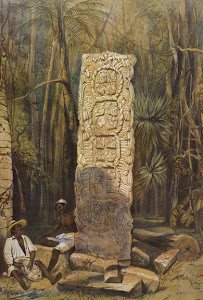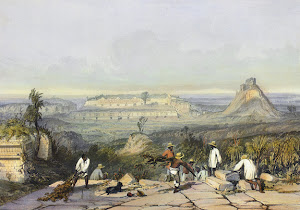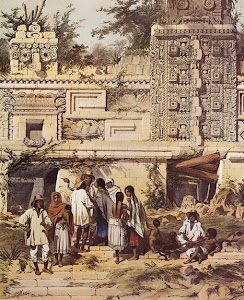Lámina 14: Parte de un edificio, Las Monjas, Uxmal
Plate 14: Portion of a Building, Las Monjas, Uxmal (por A. Picken)
_
 __"Uxmal alberga a varias ruinas Maya que fueron documentadas por Catherwood y Stephens, incluyendo la estructura que vemos en esta lámina. La fachada, brillantemente iluminada, atrae a la vista mediante la figura de dos serpientes aladas y entrelazadas, una de ellas con una cabeza humana dentro de la boca. Catherwood, lleno de a admiración, describe los “monstruosos fauces” de la antes mencionada serpiente, y relató en gran detalle la iconografía de las ruinas.
__"Uxmal alberga a varias ruinas Maya que fueron documentadas por Catherwood y Stephens, incluyendo la estructura que vemos en esta lámina. La fachada, brillantemente iluminada, atrae a la vista mediante la figura de dos serpientes aladas y entrelazadas, una de ellas con una cabeza humana dentro de la boca. Catherwood, lleno de a admiración, describe los “monstruosos fauces” de la antes mencionada serpiente, y relató en gran detalle la iconografía de las ruinas.__La arquitectura de este vestigio es impactante, sobre todo por el estado lamentable en que se encuentra, ya que la parte extrema derecha de la fachada se ha desprendido. Los cimientos al descubierto revelan la manera en que la estructura fue construida. El estilo de este edificio, en el que la puerta de entrada forma un recuadro que enmarca el paisaje natural, es típico de las construcciones Maya, y Catherwood lo utiliza para resaltar la naturaleza selvática a su alrededor. Los habitantes mayas contemporáneos que aparecen en la imagen muestran cuán alta es la estructura. Catherwood los muestra pacíficos y sumisos, e ingeniosamente censura la desnudez del pequeño niño de la imagen colocando estratégicamente un fragmento de una de las ruinas. Parece como si quisiera civilizar (en términos de Occidente) a los indígenas, a fin de que estén en condiciones de aparecer junto a los monumentos que tanto venera; este aspecto también se ve reflejado en su apariencia relajada y aún en el blanco de su vestimenta que contrasta con el tono oscuro de su piel. Aunque la ropa que llevan se parece a la vestimenta Maya del Siglo XIX, logra cubrir sus cuerpos de manera apropiada, siguiendo las normas y costumbres de Occidente. Catherwood no es el único que desea civilizar a los indígenas por amor al arte, aunque en el caso de esta representación la tendencia es evidente".
_____________*_*_*_*_*_*_*
_
__"Uxmal is the home to several Maya ruins documented by Catherwood and Stephens, including the structure presented here. The brightly-lit façade attracts the eye with its depiction of two entwined feathered serpents, one with a human head in its opened mouth. Catherwood, awed by these, described the latter serpent’s “monstrous jaws” and chronicled the iconography of the ruin in great detail.
__The architecture of the ruin is striking, especially since decay has set in, and the far right end of the façade is missing. The exposed foundation provides insight into the way the structure was built. The building style in which the doorway frames the natural environment is typical of the Maya, and Catherwood uses it to emphasize the wildness of his surroundings. The contemporary Maya pictured show the height of the structure. Catherwood makes them look peaceful and submissive, and he also chastens the small naked child with the use of a strategically-placed piece of a ruin. He appears to want to westernize the indigenous people so that they can accompany the monuments he so reveres. This is apparent in their leisurely appearance and even in their clothing, which is white in contrast with their dark skin. While this clothing suggests something of 19th-century Maya dress, it also covers Maya bodies appropriately according to western standards. Catherwood is not alone in his desire to westernize indigenous peoples for the sake of art, but this tendency is particularly prominent here".
_ _
__"Uxmal is the home to several Maya ruins documented by Catherwood and Stephens, including the structure presented here. The brightly-lit façade attracts the eye with its depiction of two entwined feathered serpents, one with a human head in its opened mouth. Catherwood, awed by these, described the latter serpent’s “monstrous jaws” and chronicled the iconography of the ruin in great detail.
__The architecture of the ruin is striking, especially since decay has set in, and the far right end of the façade is missing. The exposed foundation provides insight into the way the structure was built. The building style in which the doorway frames the natural environment is typical of the Maya, and Catherwood uses it to emphasize the wildness of his surroundings. The contemporary Maya pictured show the height of the structure. Catherwood makes them look peaceful and submissive, and he also chastens the small naked child with the use of a strategically-placed piece of a ruin. He appears to want to westernize the indigenous people so that they can accompany the monuments he so reveres. This is apparent in their leisurely appearance and even in their clothing, which is white in contrast with their dark skin. While this clothing suggests something of 19th-century Maya dress, it also covers Maya bodies appropriately according to western standards. Catherwood is not alone in his desire to westernize indigenous peoples for the sake of art, but this tendency is particularly prominent here".
Megan BURBANK (en Online Exhibition: Drawing From the Past)




























No hay comentarios:
Publicar un comentario